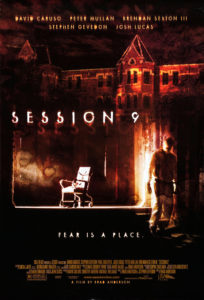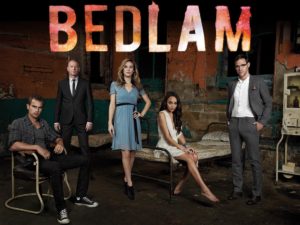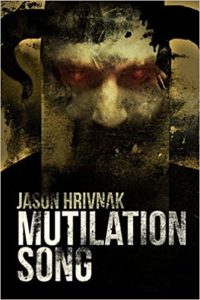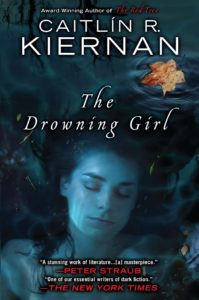Day 5 of our whirlwind horror movie tour here at Speculative Chic! More chitchat, film discussion, book recs, and cocktail ideas from Sandra Kasturi and Gemma Files! Welcome back to The Kasturi/Files!
Gemma: Today we move on to talk about what, in my opinion, stands as one of the creepiest movies ever made: Session 9 (2001, directed by Brad Anderson). Of course, I realize that by leading with this statement I’m basically opening myself up to every Tom, Dick and Harriet who loves to leave one-star reviews on Amazon (“soooo booooring,” “like literally nothing happened,” “it was decent enough I guess if ur old but skip it,” etc.), but fuck it, I don’t care. I first saw Session 9 in an all-but-deserted critics’ screening room with one other person who paused at the door to ask me, a sneer in her voice: “So, did you like that?!?” To which I answered: “I sure did!” because to me, it was — and remains — a perfect collaboration between fact and fiction producing an eternally resonant extrusion of pure mounting dread compressed into visual narrative form.
Sandra: But seriously, did you like that? Kidding! Kidding! Stop throwing things at me! Pray continue.
 Gemma: According to legend, here’s how it happened. While working on another project, Anderson discovered that the locations office he’d been doing his job out of was actually one of the few parts of the now-defunct Danvers State Mental Hospital in Danvers, Massachusetts still reckoned safe for human occupation, which the producers had discovered they could lease at a surprisingly low fee from the Danvers town council. Exploring over coffee breaks, Anderson became fascinated with the Danvers’ overwhelming sorrow-soaked sense of decay and found himself talking about it with his friend Stephen Gevedon, who would go on to both co-write Session 9‘s script and play the character of Mike, a former law student turned asbestos abatement worker, through whom the deeper mysteries of the setting communicate themselves.
Gemma: According to legend, here’s how it happened. While working on another project, Anderson discovered that the locations office he’d been doing his job out of was actually one of the few parts of the now-defunct Danvers State Mental Hospital in Danvers, Massachusetts still reckoned safe for human occupation, which the producers had discovered they could lease at a surprisingly low fee from the Danvers town council. Exploring over coffee breaks, Anderson became fascinated with the Danvers’ overwhelming sorrow-soaked sense of decay and found himself talking about it with his friend Stephen Gevedon, who would go on to both co-write Session 9‘s script and play the character of Mike, a former law student turned asbestos abatement worker, through whom the deeper mysteries of the setting communicate themselves.
So: Session 9 begins with Gordon (Peter Mullan) and Phil (David Caruso), two working-class guys who spearhead Gordon’s failing asbestos removal company. Desperate for money, Gordon wins the bid to decontaminate Danvers by telling the town council representative that his team can do all the necessary work in one week. Said team consists of depressive Scots immigrant Gordon, his increasingly untrustworthy right-hand man Phil, the aforementioned Mike, plus handsome asshole gambling addict Hank (Josh Lucas) and Gordon’s idiot nephew, nyctophobic metalhead Jeff (Brendan Sexton III). Though none of these people are exactly reliable to begin with, interaction with the Danvers only accelerates the process of their psychic unravelling — particularly those of them who occasionally end up in the former dangerous ward, the “very tip of the bat-wing,” where the patients’ “seclusions” are still decorated with murals made from not-so-random photos and words cut out from magazines and pasted directly onto the walls, like a snapshot of the inside of an insane person’s brain.
In real life, Danvers was widely known as the asylum where the pre-frontal lobotomy was first perfected, a cure-all for people afflicted with symptoms like “mortified pride.” Five years after Anderson made Session 9, it was partially demolished, hollowed out to make way for a set of condos with the front of Danvers left still attached, the weirdest possible facade. But in Session 9, Danvers is a multi-layered wedding cake of awfulness that keeps on giving. I mean, I haven’t even gotten into the records room Mike keeps sneaking away to explore, where a set of reel-to-reel tapes is labeled with the sessions they pertain to: session five, session six, session seven, session eight. . . .
Sandra: I feel like I should stand back and let you run with this one! But I’ll add in a few things. I love this movie too, and the themes it covers: our terror of insanity and our often profound lack of empathy for people who are seen to be “crazy,” the terrible things done to people with mental health issues in the last few centuries (and even now), or even people who were treated as “insane” because they saw the world differently. Or because they were, you know, women. All those wacky uteruses making us nuts! But in general, betrayal is such a deep-seated fear for most people, and is seen as one of the worst crimes you can commit: betrayal of country, of a spouse, of a child — and the most insidious one: the betrayal of your own inmost thoughts, the shifting of your personality without your realizing it. Session 9 also touches on what honor means to men, what responsibility means; how the weight of these things can destroy as easily as they can provide a code for living. Terrifying. Add to that the terror of financial destitution, of not being able to meet obligations, of disappointing family, friends. All those things come together in a subtle smorgasbord of eeriness that keeps quietly ratcheting up the tension until you’re left freaked out and shivering by the final scene.
Even the ending of the official trailer still creeps me out. Got a full body chill just watching it again:
Gemma: Yes! Since the main fear Session 9‘s action rotates around is definitely the fear of losing one’s mind, one’s self — perhaps going insane, perhaps becoming possessed, being somehow rewritten, becoming a tool for forces beyond our understanding or control — there’s a possibility that to the post-X generations, the film might ring these days as ableist, or at least supremely un-woke. There is, in fact, a potential reading of the film in which nothing supernatural happens whatsoever, though that’s not the one I personally subscribe to. But ghosts can be a lot of things, and usually are: memories, echoes, the phantom resonance of awfulness done for what seemed like good reasons at the time, back when we didn’t know any better. IN its day, after all, Danvers was supposed to be a place where people who were “sick” eventually got “better.” The fact that some of them emerged with black eyes and slower minds is one thing; the fact that some of them never emerged at all is another. As the sequence in which Hank pulls whole handfuls of coins, rings and gold-bearing teeth out of a basement wall while loudly enthusing over his own luck shows us, especially when Anderson tracks back through the hole to show the asylum’s personal crematorium lurking behind.
Sandra: I strongly object to the non-supernatural explanation! I have always found that to be a cop-out and a cheat. (Hence my crashing disappointment at the end of the film version of The Wizard of Oz, which left me, even at age seven, aghast at the liberties they’d taken with Baum’s book.) To me it always seems that when people refuse to allow a supernatural cause to crazy events in movies, when they want the reason to just be that people are nuts, it’s all in their heads, it smacks to me of the desire to control all narratives so nothing truly unexpected can ever take place. Which I think ties into my impatience with people who refuse to read genre fiction. It’s like living your entire life denying the joys of “what if . . .” And who wants that kind of dull interior life?
I think, too, that one of the reasons the film may seem un-woke is that it’s nearly twenty years old, so some things may feel dated. And the characters are all men, which will make some people really upset. Personally, I don’t mind if there are no women in a film. I’d prefer that to tokenism, or shoehorning in a female character just for the sake of appeasement. Sometimes men do shit without women. Sometimes women do shit without men. That’s just life. Would it be nice if there were more movies with only women? Sure. Does it mean we refuse to accept movies with only men? I don’t think that’s the answer. And perhaps it is ableist, as you say, but that doesn’t mean that the terror of losing one’s mind, of somehow not being oneself any more, isn’t a real one. (But this is a whole discussion that is better left to a place and time where it can be delved into seriously, rather than as a sidebar to a discussion about the movies Gemma and I like, where it’s possible to seem cavalier about serious issues, when we don’t mean to be.)

I just wanted to add that if you’re looking for more eerie doings in old insane asylums, I personally (mostly) loved the British TV series from 2011, Bedlam starring Theo James (Divergent, etc.), which is about an old asylum that is very haunted and is being converted into posh apartments/condos. Which seems like a terrible idea. And it certainly proves to be. The series is ultimately frustrating because James only stuck around for Season 1, and Season 2 didn’t pack as much punch, and the whole thing petered out without really providing any kind of satisfactory conclusion. Someone reboot this, please!
Cocktail: Midnight Madness
Sandra: I think the Midnight Madness cocktail seems (somewhat frivolously) apropos for Session 9! Or, if that’s not enough, you can always try out “8 Seriously Strong Cocktails That Are Borderline Insane.”
 Midnight Madness Ingredients:
Midnight Madness Ingredients:
1.5 oz Patrón XO Café (a blend of coffee liqueur and tequila, though theoretically you could just get a bottle of regular tequila and some Kahlua and mix ’em up?)
1.5 oz dark rum
2 dashes aromatic bitters
Orange zest for garnish
You might be paralytic after having a couple of these, so be careful! And don’t drink and drive or do other stupid shit, you know?
Book Recommendations
Sandra: Mutilation Song by Jason Hrivnak, which is about demonic possession masquerading as mental illness. Or vice versa? You decide.
One of the reasons I love living in the times we are living in now is that you can Google anything. As I was trying to think of other books that seemed thematically similar to Session 9, I googled “supernatural insane asylums” and of course there’s a list on Goodreads! Evil Hospitals and Asylums! Perfect. (Though it does include non-genre books like One Flew Over the Cuckoo’s Nest and Girl, Interrupted. Both good, but not perhaps what I’m going for, here. So, YMMV.)
Gemma: Man, I was having a hell of a time thinking of a book rec to go with this, but I think I’ll have to point folks towards Caitlin R. Kiernan’s The Drowning Girl, in which the main character/narrator is unreliable for a bunch of different reasons, only one of which is the fact that she’s a diagnosed schizophrenic who spends at least one chapter completely off her meds. Though really, when you think about it, Kiernan is one of the best at that particular game that I can think of, offhand — almost anything she’s written will show you what it’s like to go through life balancing on the thin edge of the am-I-losing-my-mind wedge, be it long-form, short-form, or packaged as a graphic novel. Another person who excels at finding the creep hiding inside seemingly mundane activities is Soren Narnia (his real name), the writer/performer behind the hypnagogic monologues of Knifepoint Horror, a podcast available most places podcasts are available. Start with “Laborer” and “Moonkeeper,” and keep going.
 Sandra Kasturi is the publisher of ChiZine Publications, winner of the World Fantasy, British Fantasy, and HWA Specialty Press Awards. She is the co-founder of the Toronto SpecFic Colloquium and the Executive Director of the Chiaroscuro Reading Series, and a frequent guest speaker, workshop leader, and panelist at genre conventions. Sandra is also an award-winning poet and writer, with work appearing in various venues, including Amazing Stories, Black Feathers: Dark Avian Tales, Prairie Fire, several Tesseracts anthologies, Evolve, Chilling Tales, ARC Magazine, Taddle Creek, Abyss & Apex, Stamps, Vamps & Tramps, and 80! Memories & Reflections on Ursula K. Le Guin. She recently won the Sunburst Award for her short story, “The Beautiful Gears of Dying,” in the anthology The Sum of Us. Her two poetry collections are: The Animal Bridegroom (with an introduction by Neil Gaiman) and Come Late to the Love of Birds. Sandra is currently working on another poetry collection, Snake Handling for Beginners, a story collection, Mrs. Kong & Other Monsters, and a novel, Wrongness: A False Memoir. She is fond of red lipstick, gin & tonics, and Idris Elba.
Sandra Kasturi is the publisher of ChiZine Publications, winner of the World Fantasy, British Fantasy, and HWA Specialty Press Awards. She is the co-founder of the Toronto SpecFic Colloquium and the Executive Director of the Chiaroscuro Reading Series, and a frequent guest speaker, workshop leader, and panelist at genre conventions. Sandra is also an award-winning poet and writer, with work appearing in various venues, including Amazing Stories, Black Feathers: Dark Avian Tales, Prairie Fire, several Tesseracts anthologies, Evolve, Chilling Tales, ARC Magazine, Taddle Creek, Abyss & Apex, Stamps, Vamps & Tramps, and 80! Memories & Reflections on Ursula K. Le Guin. She recently won the Sunburst Award for her short story, “The Beautiful Gears of Dying,” in the anthology The Sum of Us. Her two poetry collections are: The Animal Bridegroom (with an introduction by Neil Gaiman) and Come Late to the Love of Birds. Sandra is currently working on another poetry collection, Snake Handling for Beginners, a story collection, Mrs. Kong & Other Monsters, and a novel, Wrongness: A False Memoir. She is fond of red lipstick, gin & tonics, and Idris Elba.
 Formerly a film critic, journalist, screenwriter and teacher, Gemma Files has been an award-winning horror author since 1999. She has published two collections of short work, two chap-books of speculative poetry, a Weird Western trilogy, a story-cycle and a stand-alone novel (Experimental Film, which won the 2016 Shirley Jackson Award for Best Novel and the 2016 Sunburst award for Best Adult Novel). Most are available from ChiZine Publications. She has two new story collections from Trepidatio (Spectral Evidenceand Drawn Up From Deep Places), one upcoming from Cemetery Dance (Dark Is Better), and a new poetry collection from Aqueduct Press (Invocabulary).
Formerly a film critic, journalist, screenwriter and teacher, Gemma Files has been an award-winning horror author since 1999. She has published two collections of short work, two chap-books of speculative poetry, a Weird Western trilogy, a story-cycle and a stand-alone novel (Experimental Film, which won the 2016 Shirley Jackson Award for Best Novel and the 2016 Sunburst award for Best Adult Novel). Most are available from ChiZine Publications. She has two new story collections from Trepidatio (Spectral Evidenceand Drawn Up From Deep Places), one upcoming from Cemetery Dance (Dark Is Better), and a new poetry collection from Aqueduct Press (Invocabulary).




I remember this movie! I remember really liking it, though specific details as to specific instances have escaped me. I do love the ambiguity in any horror of is this supernatural or is this all in someone’s head? There’s a wonderful way to thread that needle, and I don’t remember how well this movie does that. And I really want to try that drink!
I TRIED THE DRINK!!! I didn’t use Patron’s version, but we had a version that Cabo released forever ago! This was pretty good, though I hear you, it’s pretty deceptive. You don’t taste the alcohol at all.